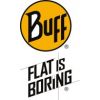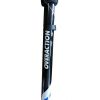Hangboarding for beginners

The best exercise for climbing is climbing as they say. However, if you want to level up quickly, you'll need to build endurance and strength in your hands as well as your fingers. Unlike hands, fingers have no muscles. But they have tendons and ligaments that are attached to the muscles of the palm and hand and need practice to increase their strength Hangboarding (or fingerboarding) is an excellent exercise for strengthening the fingers and hands and its presence contributed spectacularly to the evolution of climbing
Some History lessons
The 80’s drastically changed the nature of the sport in many areas. The first climbing shoes with rubber soles made their appearance by the Boreal company (the well-known Boreal Fire), a fact that enabled the climbers of the time to have a much better "grip" on the rock. Sport climbing began to gain popularity, while at the same time the first hangboards were developed, which helped athletes to exercise their hands and fingers in a targeted way. John Bachar was the first to turn his garage into a climbing gym by screwing long, narrow sticks around the ceiling, on which he would hang and do pull-ups.

Photo: John Bachar in his garage
Later he designed a gymnastic instrument for climbing, the so-called Bachar Ladder, which you could carry and practice anywhere.

The idea initially divided the climbing community and created objections from many athletes as training on false grips was initially considered "cheating", but as soon as the first results of targeted training were seen the climbing public got excited and this sparked new ideas. Specifically Jerry Moffat who climbed “The Face” in Germany, the first 5.13c worldwide, and Wolfgang Güllich who climbed the first 5.13d (the “Kanal im Rücken”), designed the Campus Board which revolutionized the field of climbing.

Photo:The first Campus Board
Campus Board
The Campus Board is a large board nailed on the wall with a negative tilt. It has many lines of edges on it and the purpose is to start low and climb higher through a form of “jumping”. The Campus Board is specifically used for dyno movement training as the goal is to move from lower grips to higher grips with dynamic movements. Since there are no foot holds, the arms and core are worked out a lot. Due to the fact that it is a very demanding form of exercise, it is recommended for climbers of moderate and increased ability and not for beginners.
Overall the combination of improved shoes with targeted training using the first hangboards and campus boards of the time, allowed real leaps to be made in the field of climbing. Routes unimaginable for climbing in the past have been conquered and climbing has advanced even further increasing the level of difficulty beyond imagination.
Today the design of hangboards and campus boards have evolved a lot. Countless combinations of different grips, materials and designs are available on the market to cater to even the most demanding athletes.

Photo: Contemporary Campus Board
Hangboards
As the name suggests, hangboards are made for hanging. They are not made for pull-ups, although most people use it for that as well. The goal is to hang for a few seconds at a time by choosing a hold. There are different types of grips, either for the palm, or for all fingers, or just two or just one. The smaller a hold, the greater the difficulty.
There are many different types of fingerboards/hangboards available, so it's important to choose one that suits your needs. Hangboards are made of either plastic or wood. Wood is friendlier to the hand but harder to hang on to so is a better choice for more advanced climbers.
There are large ones with many edges and different types of holds or even small transportable ones. Let's look at some options.









For more options on hangboards check out here.
Hangboard exercises

The most common (for intermediate-advanced climbers) is a 7:3:6 interval. That means hanging for 7 seconds, resting for 3, and doing 6 reps. 6 repetitions are considered a set. Ideally you will do 6 sets every day or as often as you can with 3-5 minutes of rest in between.
The exercises can be done with your body weight or with extra weight.
Some basic hangboard exercises you can try include:
Hang: This is the basic hangboarding exercise. Stand on the hangboard with your fingers on handles that are level. Hold the position for 30-60 seconds.

Open hand hang: This exercise is similar to the hang exercise, but you use the grip with an open palm.
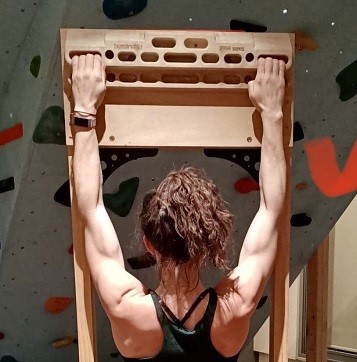
Crimping: This exercise is similar to the hang exercise, but you use the grip with a clenched palm. We can use the thumb to "lock" the other fingers, in that case we have a full crimp.

Pinch: We use an oblique or vertical handle which we “pinch” to hold on to.
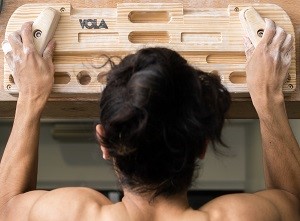
Pocket: In this exercises we use 2 fingers.

Mono: In this exercise we only use 1 finger.

Edge: This exercise is similar to the hang exercise, but you use a grip that is flat and narrow.
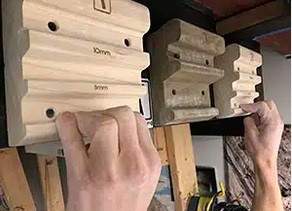
You can adjust these exercises to increase or decrease the level of difficulty. For example, you can use grips that are sharper or narrow to increase difficulty. You can also use grips that are at different levels to target different muscle groups.
Tip: We don't let our body hang completely relaxed with the elbows stretched because it can quickly bring us an injury. When we hang we activate the shoulders and back to support the arms and joints.

- It is important to start with a gentle workout and gradually increase the duration and difficulty of your exercises. Listen to your body and stop if you feel pain.
- The hangboard is a very good exercise for strengthening the fingers, but it hides the risk of injuries to tendons and ligaments which take a long time to heal. Therefore, it is good to study in detail the correct techniques for each exercise and not push yourself more than necessary. The bottom line is that the hangboard will begin to have an effect with consistent and frequent repetition within the week. Not with its infrequent but intense use.
Sources
https://blog.movementgyms.com/quick-hangboard-workout
https://www.climbinganchors.com.au/hangboard-training/
https://www.rei.com/learn/expert-advice/how-to-use-a-hangboard-to-train-for-rock-climbing.html
https://trainingforclimbing.com/4-fingerboard-strength-protocols-that-work/
https://hardclimbs.info/campus-board-vs-hangboard/
https://www.rockstarvolumes.com/post/the-history-of-the-hangboard
https://crankclimbing.org/2020/04/hangboard-training-part-1-brief-history/
Recent posts
-
24/05/2024Backpack Guide Part Α’ 10 – 30 L
-
20/03/2024Guide for crampons
-
19/02/2024Hangboarding for beginners
-
06/02/2024Rock Climbing in Occupational Therapy
-
23/11/2023Climbing Grades
-
22/11/2023Climbing in psychotherapy
-
16/11/2023What is Bouldering
-
15/11/2023Trad VS Sport Climbing
-
15/11/2023Winter Tents
-
07/11/20233 Season Tents
-
03/11/2023Summer Tents
-
02/11/2023Lifespan Of Your Climbing Gear – Part B Metal Components
-
02/11/2023Lifespan Of Your Climbing Gear – Part A (Harness, Rope, Slings and Webbing)
-
30/10/2023Nail Vernis Aquaglutene - Vade Retro
-
30/10/2023THE LOG BOOK
-
30/10/2023Mountain cookware
-
30/10/2023Our Blog
-
30/10/2023Climbing Shoes - Quick Buying Guide
-
30/10/2023Washing and maintenance of the sleeping bag
-
30/10/2023Superlight Tents
-
30/10/2023ΙNFORMATION FOR CRAMPONS
-
30/10/2023Ice axe
-
30/10/2023INFLATABLE MATTRESS SLEEP
-
30/10/2023Nikwax secrets of waterproofing
-
30/10/2023What Is “Softshell”?
-
30/10/2023Slacklining, ένας εναλλακτικός τρόπος γυμναστικής.
-
30/10/2023Mountaineering - Hiking Boots
-
30/10/2023Waterproof Membranes
-
30/10/2023Sleeping Bags
-
30/10/2023Sleeping Mats
-
30/10/2023Base Layers
-
30/10/2023Climbing Helmets






























